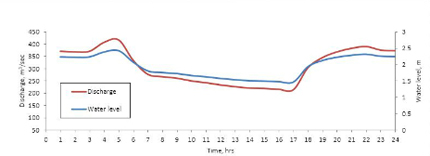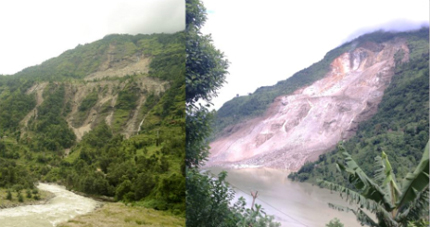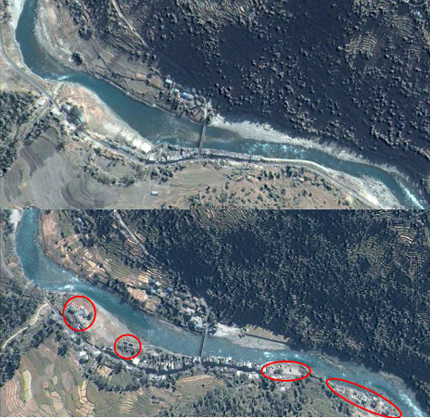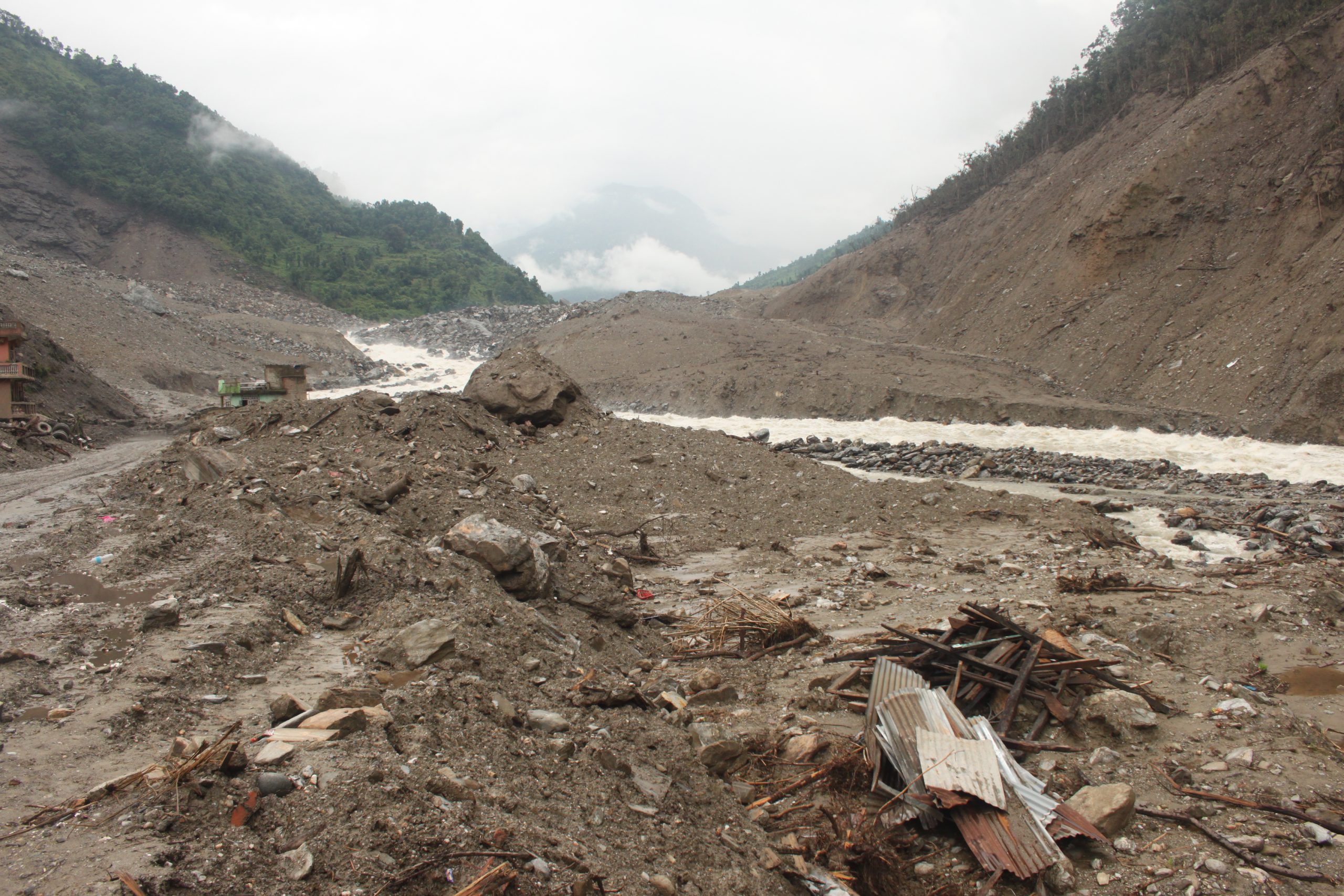In the early hours of 2 August 2014, a landslide occurred above Jure village, about 1.4 km upstream of the Sunkoshi Hydropower project’s intake site. In an instant, a 1.9 km long slope of land perched 1,350 metres above the river bed collapsed.
The massive landslide created a high dam across the Sunkoshi river. A river gauging station of the Department of Hydrology and Meteorology (DHM) at Pachuwarghat about 38 km downstream of the landslide dam showed a rapid decline in water flow three hours after the landslide, after which the flow of water completely stopped for approximately 12 hours.

An inflow of about 160 cubic metres per second (cusec) of water quickly created a large lake behind the dam. Within 13 hours the newly formed lake – which rapidly grew to a volume of an estimated seven million cubic metres – extended about three km upstream, completely submerging the 2.6 MW Sanima hydropower station.
Had Nepal’s security forces not taken timely action to release some of the stored water through controlled explosions, the backwater would have extended further upstream and caused great damage in Barabise, the nearest upstream town.
However, the risk that the dam will breach still remains, bringing with it the threat of a catastrophic flood. Nepal’s Home Ministry has declared the area a ‘flood crisis zone’, and has issued a warning to communities downstream, with many vulnerable villages being evacuated.
It cannot be predicted when and how the landslide dam will erode and how the stored water will be released. However, it is probable that the Arniko Highway, a major trade link between China and Nepal with exchange that stands at nearly at 38 million Nepali rupees per day (nearly $400,000), will remain blocked for a long time.

This could mean serious medium-term impacts for Nepal. Damage from the landslide has already interrupted power supply from several hydropower plants in the valley, including the Sunkoshi and Bhotekoshi power plants, adding to the country’s power crisis.
Monitoring hazards to prevent disasters
This is not the first time the Sunkoshi valley has experienced a lethal flood, and this is certainly not the last time. Like many places around the Hindu Kush Himalayan region, the Sunkoshi’s weak geological formation and steep topography combined with frequent intense rainfall and the increasing impact of climate change makes it prone to different types of water-induced hazards, including landslides.
Over the last 30 years, the Sunkoshi valley has experienced three major floods. In 1982, a landslide dam outburst flood (LDOF) in the Balephi river, a tributary of the Sunkoshi, killed 97 people. Another flash flood in 1987 killed 98 people, and a 1996 flood swept away Larcha village, killing 54 people.
The valley is also vulnerable to the outburst of growing glacial lakes located in the northern part of the catchment in the Tibet Autonomous Region of China. In 1981, the Zhangzangbo glacial lake located 20 km upstream of the Nepal-China border breached; the resulting flood caused extensive damage in Nepal from the border down to the village of Dolalghat.
Landslides and other natural disasters are also common outside the Sunkoshi valley. Nepal alone experienced 13 large landslides between 1967 and 2010, the most recent being the 2010 Madi landslide in central Nepal.
Recent natural disasters across the Hindu Kush Himalayan region include the Swat valley flash flood and Attabad landslide in Pakistan in 2010; the 2012 Seti flash flood in Nepal; the Uttarakhand flash floods in June 2013; and the landslide in Badakhshan, Afghanistan this May.
Although we cannot control natural hazards like landslides and floods, there are many things that can be done to minimize their adverse impact on lives, livelihoods, and valuable infrastructure. More efforts to map landslide risks are needed, and much more frequent monitoring of potential landslide sites is necessary. Both will help in designing mitigation measures and reducing risks.
In hindsight, photos from 2013 show a number of scars along the mountain slope in Jure. If there had been an appropriate monitoring mechanism in place, measures could have been taken to raise awareness about the potential of a larger land slip. While the exact timing and size of landslides are difficult to predict, potential landslide areas can be mapped relatively accurately and the approximate size of the potential landslide can be calculated.

Knowledge and information from past disasters can also support disaster risk management. Regular monitoring of hydrological and meteorological variables generates valuable information that can be fed into hydrological models. These models can be used to provide information about areas at risk of inundation during a flood event, including for potential glacial lake outburst floods. This type of analysis can be used in zoning river corridors and preparing land use plans.
Putting planning into practice
While zoning and land use planning are essential elements of risk management, these efforts are futile if not properly implemented. Despite an entire village being washed away by the 1996 Larcha flood, a village has been resettled in the same location. With these settlements constructed along the flood plain, many households remain at risk of being destroyed in future floods.
Even commercial enterprises are taking calculated risks, with a mini-hydropower project now constructed in Larcha. In areas with significant commercial activity like Khadichaur, the construction of settlements along the flood plain has increased in the past decade.

Across the Hindu Kush Himalayan region, improper or insufficient planning of infrastructure and settlements has put lives and investments in harm’s way. It is believed that unregulated and haphazard development is partially to blame for the severity of the 2013 Uttarakhand disaster. During such events infrastructure may also create additional risks, for example when stored water is released from hydropower reservoirs into river channels that are already full.
The 1981 GLOF in the Sunkoshi valley showed the value of proper planning. Following the 1981 flood, more than $3 million was spent to rebuild the Arniko highway. During this process, the 27 km stretch of road damaged by the flood was raised 20-30 metres above its previous position, and the three destroyed bridges were replaced with arc structures. Both moves reduced the potential losses of infrastructure during future floods.
Enhancing cooperation to reduce risk
Because of the transboundary nature of rivers in the Hindu Kush Himalayan region, events of a large magnitude often impact more than one country. The government of Nepal has informed the government of India about the potential threat of flooding should there be a sudden outburst of the temporary lake formed behind the landslide dam. Recognizing the risk for communities downstream, all of the gates of the Saptakoshi barrage, which is under the control of the government of Bihar, were opened. The Bihar government has sounded a flood alert in eight districts and have begun the evacuation of nearly 200,000 people living along the Koshi embankment in India.
The governments of China and India have already offered technical support to the government of Nepal in its response to the Sunkoshi event. China has good experience in managing mountain hazards, including a landslide following the 2008 Wenchuan earthquake that blocked a valley. Their technical expertise would prove invaluable in managing the massive landslide in the Sunkoshi valley.
However, this cooperation should be extended beyond this particular event to long-term transboundary collaboration in managing risks, including in regular monitoring and assessment of potential risks and the implementation of early warning systems.
The scale of the Sunkoshi landslide is beyond the capacity of local communities to manage alone. However, national governments must promote the central role of communities in landslide risk management, including preparedness, adaptation and mitigation. This is especially true in remote areas where limited access can delay national disaster response efforts.
Consultation with local communities and the use of indigenous knowledge is crucial, particularly in the case of landslides. Use of indigenous knowledge in scientific and technical risk assessments can strengthen the resilience of communities, help communities take decisions informed by their own knowledge, and, when combined with scientific data, correct their own misperceptions about potential risks. This will help communities translate risk perceptions into enhanced preparedness for landslides and other hazards.
By Arun B. Shrestha, Narendra R. Khanal, Mandira Shrestha, Hari Krishna Nibanupudi and David Molden.The authors work for the Kathmandu-based International Centre for Integrated Mountain Development (ICIMOD), which is a knowledge partner of The Third Pole

